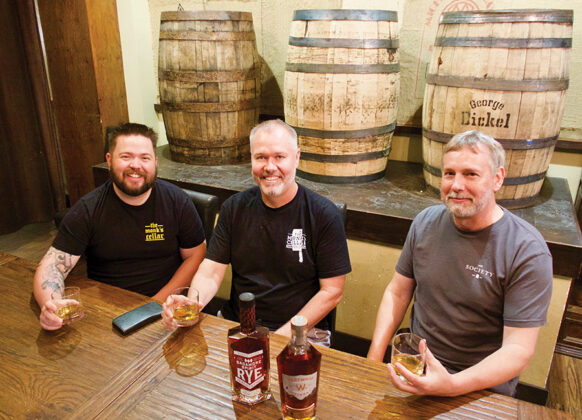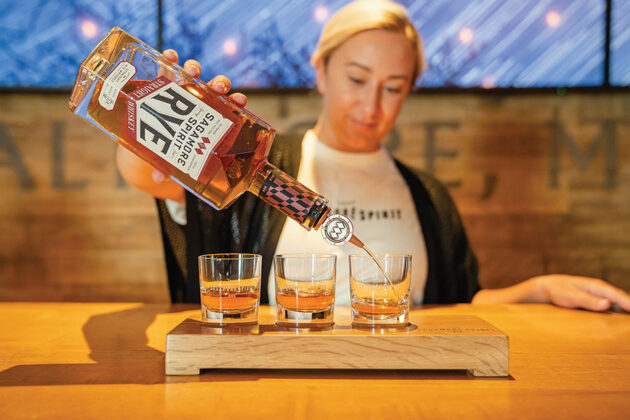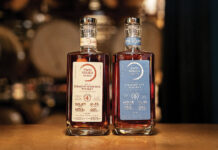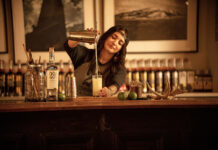The Roman poet Horace had already noticed in 23 B.C.E. how much carefree camaraderie flourished with communal libations. “Whom will Venus pick to be judge of the drinking?” he wrote. “To me it’s sweet to lose my mind — my friend is back.”
The good will and solidarity that blooms in drinking culture seems to be reaching new heights with people’s shared love of whiskey. Appreciation clubs dedicated to the greatness of distilled grains are now popping up all over the United States.
For stores and taverns, facilitating one of these clubs can do wonders for building a larger and more loyal client base. For a newer distillery, working with them on barrel selections and sales is a novel tool for distribution, not to mention broadening a label’s reach.
“There’s a kinship that happens there,” says Brian Treacy, founder of Maryland’s Sagamore Spirit. “Working with these whiskey clubs is really a way of getting to know people who love the spirit; and it’s almost like being friends with them. And what’s so great about whiskey clubs is that they have a thirst for knowledge — they want to understand everything there is about your brand, your company, the people who work there, and certainly what goes into the bottle. And, if we get the opportunity to work with them, these clubs actually become whiskey educators.”
A Barrel Full of Enthusiasm
Sagamore Spirit got involved with whiskey clubs for a simple reason: It’s taking on a big cultural mission, and it needs true believers.
In America’s colonial era, Maryland was a geographic anchor for distilling. By the 1800s, the state had become renowned for making special bottles of rye. When 1910 rolled around, Maryland had 44 distilleries that were collectively pushing rye’s reputation to new limits. Some of the artisans doing that work along the Chesapeake Bay managed to keep going through Prohibition, which reinforced Maryland’s mantle as “the Free State.”
But the industry was slowly bleeding out by the second half of the 20th century. The last Maryland distillery closed its doors during the Reagan administration. At that point, it appeared more than two centuries of know-how was dying with a whimper.
Now, Sagamore Spirit is one of the distilleries taking back the legacy of Maryland’s rye-craft. It’s seen progress in that direction, including acquiring Sagamore Farm, a sprawling planter’s paradise once famous for raising thoroughbred racehorses.
“Come to find out, the whole farm is built on a shelf of limestone aquifers,” Treacy says of the place.
That happy discovery has allowed Sagamore Spirit to use the farm’s limestone spring water to proof all of its whiskeys into the barrels as well as into the bottles. The distillery operates two other farms: Between all its sites, the company has already harvested 50,000 pounds of Maryland-grown rye.
Treacy adds, “Even though the last distillery closed decades ago, that identity, that style, that brand — Maryland-style rye whiskey — lived on the entire time without anyone in the state actually making it.”
In its quest to revive the tradition, Sagamore’s portfolio consists solely of rye whiskey. It wants its brand to be known for working to master a recently lost art.
Sagamore is aiming high with its rye. But since it’s only five years old, it still has a way to go on name recognition. Maryland’s whiskey clubs are helping change that equation.
In Maryland, some clubs’ trajectories are tied to Allview Liquors, a store in Howard County with a reputation as the go-to spot for rare and top-tier spirits. Whiskey clubs in Maryland can buy barrels from a distillery only via a licensed distributor or a business working with one. Three of the region’s biggest clubs, The Bmore Whiskey Group, The Maryland Bourbon Society, and The Old Line Bourbon: Private Barrel Club, have decided that Allview Liquors is the ideal partner for their drinking adventures. One of the distilleries that sells barrels through Allview is Sagamore Spirit.
Allview’s owner, Justin Jarvis, has worked with whiskey clubs since 2014. He sees being the middleman as a low-risk, high-reward endeavor for his own business.
“Most of this stuff is pre-sold,” he notes. “You don’t have to worry about sitting on product, so it works out really good. On my end, it’s just paying for the barrel purchase with a credit card and the expense of my employees filling up the bottles. Overall, there’s a big benefit to us.”
Jarvis has also partnered with George Fotis, owner of Drug City Liquors in Baltimore, to release a Maryland Heritage Rye series that caters to longtime club members. These store-selected bottles come from a collection of three distinct batches and three single barrels designed to celebrate Maryland’s past. Adding Fotis’ business to the barrel-select synergy brings another benefit to all involved: His store has an upstairs speakeasy that holds 40 people, where any of the clubs connected to Allview can have get-togethers or tasting events. Jarvis says sometimes the clubs muster there, while other times they take trips to the distilleries they’re interested in. Either way, Jarvis points out, they almost always include a charity fundraising component to their activities.
“Whiskey is hot right now, and I couldn’t have guessed even five years ago we would be selling the amount that we are,” he admits. “But the nice thing is, with all of these groups, a lot of the money is actually going back to the community. These are whiskey enthusiasts for sure, but this isn’t just about them getting to pick barrels. They really want to make it about doing something good.”
Finding Fellowship Through Obsession
At sunset on a breezy California evening, 50 whiskey zealots started gathering in Roseville, a timeworn but vibrant railroad town 20 miles north of the Golden State’s capital, to attend a soiree dedicated entirely to Sagamore Spirit’s rye. It was hard to say who was more eager: the thirsty members of The Monk’s Cellar’s whiskey club, or the brand ambassador from Sagamore, who was being offered a great chance to connect with potential drinkers on the West Coast.
For eight years, The Monk’s Cellar has brewed award-winning Belgian and English-style ales, which the brewery’s kitchen pairs with outstanding elevated pub food. That approach has built a following, and so has its growing reputation for whiskey appreciation. On any given night, its bartenders pour from more than 70 bourbon, Scotch, rye, and Irish whiskey labels.
When the pandemic first set in, its owners, Paul Gould and Andy Klein, saw an opportunity to bond with patrons who loved that particular element of their business. In early 2020, California officials hurried to help struggling restaurants withstand the pain of mandatory lockdowns by allowing them to sell to-go drinks. They were also allowed to sell bottles of spirits over the bar. Gould and Klein decided to start a whiskey club to harness the brewery’s buying ability with distilleries. It was then complemented with contributions from a cadre of whiskey devotees, opening the door for everyone to buy and share rare individual barrels through Monk’s license and industry contacts.
More than 60 whiskey-loving customers joined the club. Then, California extended its regulatory change all the way into 2026, which means Monk’s club isn’t going anywhere.
“Having the option to include bottles to go with club membership was a big factor in deciding to put the club together,” says Gould. “It meant that, if we got the number of members to where we wanted it, they would use the majority of the whiskey from each barrel … And there’s the added benefit of being a place that buys whole barrels, which raises the profile of the bar program as a whole.”
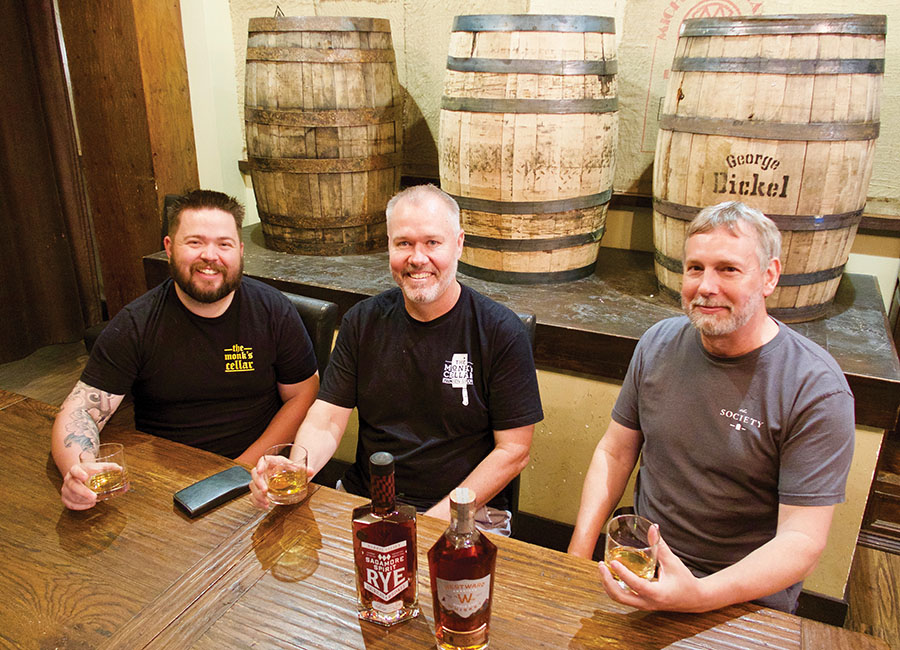
Photo by Scott Thomas Anderson
Monk’s Cellar is coordinating five or six annual barrel purchases and release parties a year for club members. So far, it’s worked with a mix of legacy brands that include Maker’s Mark and George Dickel, as well as newer distilleries that are still getting the word out about what they do.
“I think it was important to find a little balance there,” Klein reflects.
Some distilleries have even helped to host events. After the club bought a barrel from Westward Whiskey in Portland, Oregon, the distillery sent market manager Gian Trinidad to Roseville to host the release gala and walk members through an educational tasting. Sagamore Spirit’s market manager Nick Jones likewise showed up to host the tasting and provide background on everything that was being poured, including the members’ private barrel.
Club member Michael Dobbs said the pours made him a fan of Sagamore Spirit. He was also very happy with the club’s barrel from the distillery. It wasn’t hard to taste why: Monk’s Sagamore Select has a taste of hot honey-fire up front, followed by pings of molasses and a chocolatey charcoal melt that strengthens with each sip.
Jones stresses that club members and distilleries both win at these kinds of events.
“I got a lot of great questions and a lot of interest from the people who were here tonight,” said Jones as the evening tapered down. “Some of these club members may never have had Sagamore in the past, which makes it nice to let them try and experience it for the first time. For club members, they’re getting a one-of-a-kind product — a one-of-a-kind whiskey. For us, we’re getting awareness. We’re still kind of a new company getting off the ground, so whenever we interact with a lot of whiskey enthusiasts, it makes for a great situation.”


